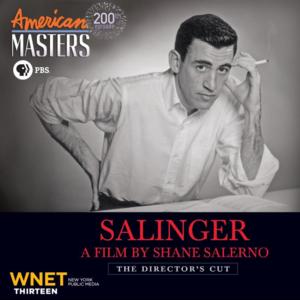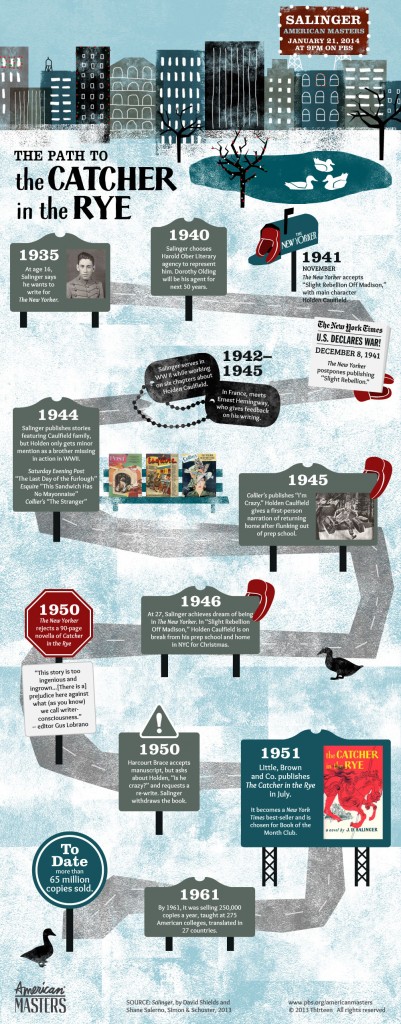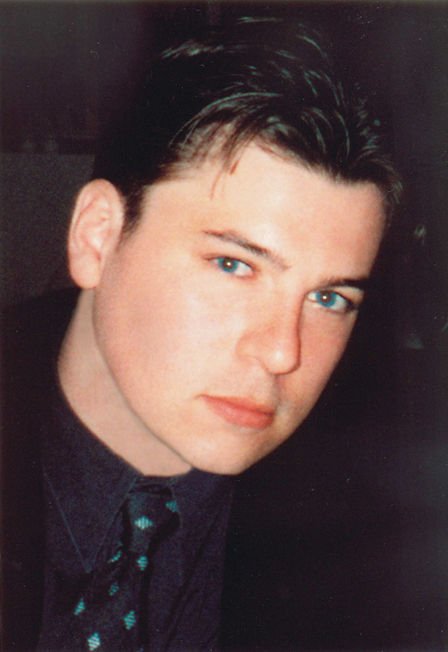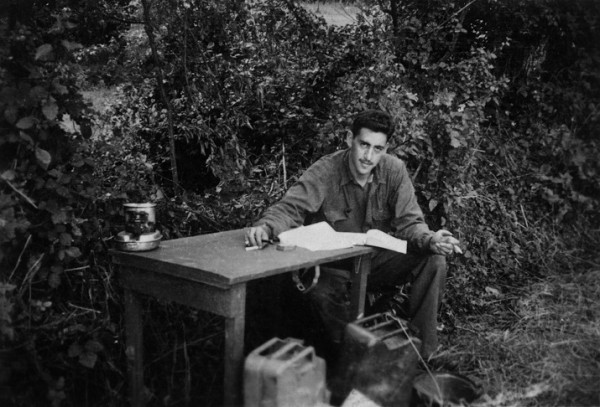
The documentary Salinger (and the novel that goes with the film) tells the epic story of author J. D. Salinger, best known as the author of seminal coming-of-age novel, The Catcher In the Rye. Catcher has remained an oft-discussed piece of literature, as more often than not, new readers discover the isolated hero, Holden Caulfield and almost immediately connect to him. Salinger is directed by blockbuster filmmaker Shane Salerno, whose credits include Armageddon, Savages and the upcoming Avatar 4. Salinger finished in the top ten highest grossing documentaries of 2013 and maintains a solid 4 out of 5 rating on Netflix.
The companion book debuted as a New York Times bestseller at #6. It tracked #1 on the L. A. Times bestseller list, as well.
I went about setting up the interview with Salerno as I typically would, and was told I would get fifteen minutes with the guy. This is typically normal, as filmmakers are busy folks and have a ton of interviews scheduled for that day, so you get fit into a time slot and go from there. Well, this wasn’t the case with Salerno. He ended up giving me around 45 minutes or so of time, some of which was spent BS-ing about our shared love of Michael Mann.
Rob Ottone: How did you get involved in the Salinger business?
Shane Salerno: Well, I’m a book collector. I have a 15,000 book library and I walked into a book store and found this biography of Salinger and, this was more than ten years ago, it had this very haunting photograph of Salinger from 1951, at the prime of his life, superimposed over an image of him later in life. The two images were so striking, I picked up the book. I had read Salinger as a young man and I loved Salinger’s writing, but like a lot of people, I had no idea about his life. I knew his work. I read this book in one sitting, overnight, and was shocked to find that J. D. Salinger’s first day of combat was D-Day, you know? That J. D. Salinger lost the love of his life to Charlie Chaplin. That J. D. Salinger checked himself into a mental institution at the end of the war.
These things were just shocking to me and the more I read, the more fascinated I became of this Park Avenue rich kid who desperately wanted to be in World War Two and was, in fact, rejected because he had this romanticised view of war. He had this almost-Hemingway notion of war and that changed over the course of one year in 1944-1945 where he really saw firsthand some of the bloodiest battles of World War Two, including the Battle of the Bulge, Battle of Hurtgen Forest, the hedgerows, some really brutal fighting. And of course, at the end of the war, he walked into a concentration camp. So, he got the full and total horror of World War Two.
When I was done reading this book, and I’ve only had this experience a few times, I just had to do it. I didn’t know it was going to take ten years of my life! I was thirty when I started, forty when I finished. I don’t recommend that. I originally was going to shoot for six months and spend $300,000 and I ended up spending $2 million of my own money, and I don’t recommend that, either.
The fact that it worked out in the end and hit for all these records didn’t change the fact that for ten years, there was this terror that was basically wondering whether the story would connect with a wide audience. Thankfully, it has.
Rob Ottone: Ten years is a long time. What were some of the hurdles you were leaping over the course of that decade?
Shane Salerno: That’s a good question. This wasn’t like making a documentary about Ted Kennedy or Bill Gates or whoever, the man never sat for a formal interview in his life. There was no footage of him. There was less than fifteen or sixteen photographs of him, many of the owners of those photos wouldn’t sell them. There was no audio recording of his voice. There was no video of him doing anything. You had to make a two hour film with very little material.
That was the first extraordinary hurdle. Over ten years, we were able to find all these photos that nobody even knew existed, including the only photos of him at war, the only photos of him with his first wife, who was German, which is another fascinating story. We also found the only photo of him writing The Catcher in the Rye. The only photos of him and his four buddies in the counterintelligence corp. during the war, stuff like that.
This was really a detective story over the course of a decade to try and track down all these different photographs and film footage and we were able to uncover some pretty striking things. You know, those things have been on the front page of newspapers all over the world, so people have been fascinated by them.
Rob Ottone: Do you feel that younger audiences connect to Catcher as much as say you or I did when we first read it in our younger years?
Shane Salerno: You know, it’s weird. There’s two real arguments to be made here. One is yes, they do. I saw evidence of this at a UCLA journalism class and we asked how many kids in the class read it. Seventeen out of the eighteen kids in the class had read it. They were aware of it, they loved it and a couple of the girls had crushes on Holden and that’s actually in the new cut of the movie, there’s a scene of that classroom in the movie.
I also encountered kids who felt it was dated and out of touch and just not fast or relevant. It just didn’t have that same effect on some of these kids the way it did on you or I. I read it when I was ten or eleven and it was very much a window to a world and a voice that I felt translated my thoughts onto paper. 
One of the cool effects of the movie, since the release, has been that not only did our book hit the bestseller list, but Catcher did again, too. It hit #7 on Amazon for the first time in decades. It was cool seeing The Catcher in the Rye hitting sales figures like that again. I don’t know if it was people reconnecting with the book or discovering it for the first time, but I hope it’s a combination of the two.
When I would do Q&As in theaters in L. A. and New York, people would come up to me and say that because of the film, they’d look at Salinger’s work differently and that, by reading Salinger’s work again, they’d look at it through a new prism. So that was cool, the idea that, even in a small part, we did have a little help in bringing it back around and keeping it relevant. That was a cool thing to be a part of.
Rob Ottone: Salinger is sort of famous for withdrawing from public life. You referenced it earlier that there isn’t much media about him out there. Is there a particular incident that, over the ten years of studying his history, that you could point at as being the reason why he withdrew?
Shane Salerno: Our strong belief in the film and the book is that he walked into that concentration camp, which was a sub-camp of Dachau, and never walked out. When he went into the war, he was a serviceable short story writer. None of the stories for which we talk about Salinger, Banana Fish, Nine Stories, none of those predominantly were written before the war. None of the essential Salinger. Catcher had been touched, but not anywhere to the degree with which he’d later finish it.
He goes into war as this Park Avenue rich kid who had not had any suffering in his life, you know? He comes out of World War Two and over the course of two years lost the love of his life and saw the horrors of war and came back, went to a mental institution, then came out and some kind of weird literary alchemy happened. He became J. D. Salinger. He needed the war to become J. D. Salinger. He needed to suffer to become the J. D. Salinger that we know. His writing completely changed. There were small and obvious examples. Holden was never in the first-person. That voice wasn’t there to the degree that we know it from the landmark novel. The pain that he writes about and connects readers with around the world, that’s all rooted in World War Two. That’s why those characters are so damaged. World War Two is the ghost in the machine for all of Salinger’s work. When you read those stories, you understand why a person blows their brains out or why they do this or that. I was shocked by the imprint of World War Two on Salinger.
It imprinted on him for life, it changed him forever. The truth is, had it not been for World War Two, we never would’ve known the name J. D. Salinger. He never allowed those early stories to be published in book form. In 1974, he told the New York Times that they were the “gaucheries of my youth.” He never considered those stories relevant. He never considered them as having the weight of Nine Stories. In fact, he went to the FBI and did a lot of things to make sure they weren’t published. The film shows that there was this bootleg publication, like we see bootleg Springsteen or Pearl Jam, what was unusual about Salinger is that he hunted the people down like he was in the counter-intelligence corp. and got the book pulled from book stores which was crazy.
In the ten years, it was crazy to be working on Salinger as a passion and still be working on Savages and Avatar, it was kind of this like, very expensive personal hobby I had going on. It all came from my love of Salinger and the love of his life. There are something like 300 books on Amazon about the guy and break down every sentence he ever wrote with all the college professors that he detested weighing in. There wasn’t a record on him. Many of the people we interviewed have passed away and if we hadn’t interviewed them, they would’ve taken their stories with them forever.
Some of those stories are really relevant. The guy who rented the house that Salinger finished Catcher in. Friends who sat on letters from Salinger for 65 years. I convinced a woman to speak to us who had kept quiet for more than 50 years. You won’t find her name in any Salinger book or article. All we had to go on when it came to finding her was that she was 16 or 17 in 1949, which was wrong, she turned out to be 14. It took us years to find her. We also only knew that her first initial was “J.” That was all we had to go on. It was like finding a needle in a nation of needles.
We finally tracked her down and it was a whole other process to get her to speak to us. She had made this pact not to speak while Salinger was alive. We were in this weird position where she wasn’t going to talk until he passed. When he did, she was ready to tell her story, which was that she began a relationship with Salinger when she was 14 and he was 30. What was fascinating was she had over 100 letters from him. The entire relationship was documented. She saved telegrams from him. “Hey, can you catch a train up this weekend?” “Hey, I can pick you up at the station,” that kind of thing. She had this extraordinary photo of him, too.
Every person we spoke to was a treasure chest of information, pictures and more. When we got to finding photos of him at war, we had heard rumors of these things. It was like the Loch Ness Monster. People had claimed to see them, but no one had known who had them. If they existed, why weren’t they in his daughter’s book? Finally, we tracked down the family of this wonderful man who had maintained a relationship with Salinger from 1944 to 2010 when they both passed away, only a few months apart. He ended up having 25 photos of Salinger than no one had ever seen before. In fact, he had lost them for a while and then found them. Those photos are all over the world now, but it was extraordinary to find them. At one point, he showed us a photo smaller than the palm of your hand and I sent my assistant out for a magnifying glass and when we got it, it was a picture of Salinger writing. It turned out that it was him writing Catcher. This guy saved his diary from World War Two, so we looked through that and it would say stuff like “Well, Jerry’s off writing again,” or something. Nobody knew him as J. D., it was always Jerry. They all knew him as a man and not this figure he’s become. His friends knew him as this warm, fuzzy, fiercely articulate guy and to the world, he was this cold, distant man who turned his back on the world. It was a fascinating dichotomy. One that exists in all great men which led us to explore, as you do with Salinger, what does an artist owe the world? What does he owe book signings? Promotion? All those things he protested.
Rob Ottone: That’s amazing, a photo of him writing Catcher.
Shane Salerno: Yeah, definitely.
At this point, we started chatting a bit about how back in the day, when Nick was heavily involved with trying to bring the novel Meg to the big screen, Salerno was the writer brought on to tackle the project with Jan De Bont directing.
Shane Salerno: We came like, about as close as you can get to making a movie without making a movie. Crew were hired. Things were being built. It was all ready to go. We had the special effects guys from The Matrix, the production designer from Master and Commander, all these things and it just didn’t happen in the end because of budget and New Line going through a weird time. We came as close as we could.
Rob Ottone: I was a fan of the site at the time that stuff was going on, I remember thinking it was a pretty cool idea.
Shane Salerno: It was not Salinger, I can tell you that. It was a big, fun movie and had a terrific experience working with Jan De Bont. In a way that I haven’t always experienced, either, he completely knew what that movie needed to be and he would’ve made a great movie. Truly. He was heartbroken when it didn’t work out.
Rob Ottone: You’ve worked with a lot of great filmmakers. What is your approach when it comes to working with a guy like Oliver Stone or Michael Bay? Is it the same approach or do you adapt differently to who you’re working for?
Shane Salerno: You certainly adapt differently to who you’re working for. The way you work with one of those guys is not how you’d work for another. Also, it’s not the way they’d want to work with you. You are constantly making adjustments and people have different worldviews, some keep Ozzy Osbourne hours, some keep banker’s hours. I’ve worked with all kinds, but you do have to adapt to their different working styles.
I’ve worked with Michael Mann a few times and he’s a huge hero of mine. I just worked with him again recently. That’s a completely unique experience. As a writer, what you’re hoping to do is work with the same people over and over again. Getting rehired by those people, as a writer, is the great endorsement of the work that you do. Repeat business with a director, you know? I’ve tried to do that and I have with a few directors. I think that’s important for writers coming up, to form relationships with people.
Rob Ottone: Can you talk a little bit about the Michael Mann project?
Shane Salerno: It’s kind of top secret and hasn’t been reported. We worked together on this thing for about two years. It might be seeing the light of day in the near-future. I came very close to making a movie with him ten years ago about the drug wars in Mexico. When we got to where it could be a reality, Traffic came out. Traffic had struggles to get made, it’s kind of a legendary story so there certainly wasn’t going to be two of them.
Salinger is dedicated to Michael Mann. He’s someone who has had an extraordinary impact on me and my life. Basically, when I was a kid, two movies had an effect on me, Thief and The Empire Strikes Back. So, if you look at my career, I’ve sort of lived in those worlds, that’s why you end up with something like Savages and why you end up with Avatar. Those two movies, which I saw a year apart, were the formative movies of my childhood. There were obviously more as I went on, but those two movies just had a huge impact on me. Michael is someone I care very deeply for as a friend, but also respect tremendously as a filmmaker. I think The Insider is one of the best films ever made. Period. I truly admire him as a total filmmaker. He writes, produces, directs. He shoots his own stuff, he’s involved in the editing and music. I was trying to tell him that the last time I saw him.
He’s someone who, when I work with other directors, they’re all fascinated by his process.
Rob Ottone: Really?
Shane Salerno: Yeah. I think it’s because he’s a total filmmaker, you know? He’s door to store, everything you see.
There aren’t a lot of guys who do that.
Rob Ottone: How excited are you for the Criterion cut of Thief?
Shane Salerno: I have to tell you a very funny story. They showed it at the Aero theater and I drove by and called Michael and asked “What kind of disturbed person wouldn’t tell somebody , who they know it’s one of their favorite movies, that it was showing?”
He laughed and said “Oh, jeez, I forgot! But just to make matters worse, it was a beautiful new print and I supervised it myself.”
We had a big laugh about it. Roger Ebert’s review of that film basically says everything we know about Michael. It’s all there. He basically says there’s a major filmmaker here and coming. The impact of the film on me and other filmmakers has been amazing. Filmmakers are huge into Thief, as I’m sure you are. Are you a big fan of his?
Rob Ottone: Oh god, yeah.
Shane Salerno: There’s a precision to his work that I greatly admire.
Rob Ottone: Every time Ali is on, I have to watch it. I can’t turn it off, no matter how hard I try.
Shane Salerno: Funny thing about Ali, there was a review of it years ago in the L. A. Times and I don’t know if you remember this, but they had a column called “Counterpunch” and I wrote a column saying how the reviewer was wrong. I re-read what I wrote a few years ago and I was like, calling out the critic. That same critic ended up giving me a great review on Salinger, so I guess he didn’t remember it. I was like “Oh my god, if he remembers that Ali thing I wrote!”
I love that movie so much. I think people thought they were going to get something very different. What they got was something that put you in Ali’s head as opposed to what some people wanted, which was this Rocky-esque thing. I don’t think it would’ve had the impact that it’s had, had it been like that.
Rob Ottone: Absolutely not. I have one more question for you. Avatar 4?
Shane Salerno: Okay, are you ready? The first rule of Fight Club is that you don’t talk about Avatar 4.
Rob Ottone: Is that a James Cameron thing? Does he gather folks together and lay that mandate down?
Shane Salerno: All I can tell you is that the first rule of Fight Club is that you do not talk about Avatar. I have no comment beyond that but it’s certainly been an extraordinary experience. Listen, I wish I could say something, but I can’t.
All in all, we had a lot of laughs and I really look forward to an opportunity to chat with Shane Salerno again about any projects he’s got coming up. Check out Salinger when it airs on PBS, January 21st at 9 p.m. Check your local listings, folks, it’s a brilliant piece of filmmaking.
